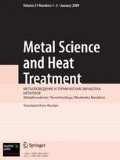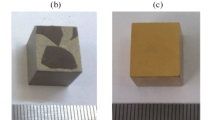Some features are provide for the change in structure and properties of commercial purity titanium during hydrogenation and their effect on formation of the final structure of semifinished products and objects after vacuum annealing. It is established that titanium hydrogenation kinetics by a thermal diffusion method and specimen structure formation are mainly determined by the temperature for introducing hydrogen.




Similar content being viewed by others
Notes
Here and subsequently in the text hydrogen concentration is given in weight fractions expressed as a percentage.
References
A. A. Il’in, A. M. Mamonov, and M. Yu. Kolerov, “Thermal hydrogenation treatment — new form of treatment for titanium alloys,” Perspekt. Mater., No. 1, 5 – 14 (1997).
A. A. Il’in, B. A. Kolachev, V. K. Nosov, and A. M. Mamonov, Hydrogen Technology for Titanium Alloys [in Russian], MISiS, Moscow (12002).
A. A. Il’in, S. V. Skvortsova, A. M. Mamonov, and M. Yu. Kolerov, “Effect of hydrogen on phase and structural transformations in titanium alloys of different classes,” Fiz. Khim. Mekhan. Mater., 42(3), 33 – 39 (2006).
O. P. Nazimov, A. A. Il’in, and M. Yu. Kolerov, “State of hydrogen in titanium,” Zh. Fiz. Khim., 54, 2774 – 2277 (1980).
S. G. Glazunov and B. A. Kolachev (eds.), Titanium Alloy Metallography [in Russian], Metallurgiya, Moscow 91980).
A. A. Il’in, A. M. Mamonov, and M. Yu. Kolerov, “Scientific bases and principles of constructing production processes for thermal hydrogenation treatment of titanium alloys,” Metally (RAN), No. 4, 157 – 168 (1994).
B. A. Kolachev, Hydrogen Embrittlement of Metals [in Russian], Metallurgiya, Moscow 91985).
V. K. Aleksandrov, N. F. Anoshkin, A. P. Beloserov, et al., Titanium Alloy Semifinished Products [in Russian], VILS, Moscow (1996).
G. P. Luchinskii, Titanium Chemistry [in Russian], Khimiya, Moscow (1971).
Results of the work were obtained in MATI with financial support of the federal target program “Research and development for priority areas of developing the scientific and technological complex of Russia for 2014 – 2020” in accordance with an agreement for supply of a subsidy No. 14.577.21.013 (unique agreement identifier RFMEF157714X0013).
Author information
Authors and Affiliations
Corresponding author
Additional information
Translated from Metallovedenie i Termicheskaya Obrabotka Metallov, No. 6, pp. 25 – 29, June, 2016.
Rights and permissions
About this article
Cite this article
Kollerov, M.Y., Mamonov, A.M., Zasypkin, V.V. et al. Features of Titanium Structure Formation During Thermal Diffusion Saturation with Hydrogen. Met Sci Heat Treat 58, 335–339 (2016). https://doi.org/10.1007/s11041-016-0013-9
Published:
Issue Date:
DOI: https://doi.org/10.1007/s11041-016-0013-9



